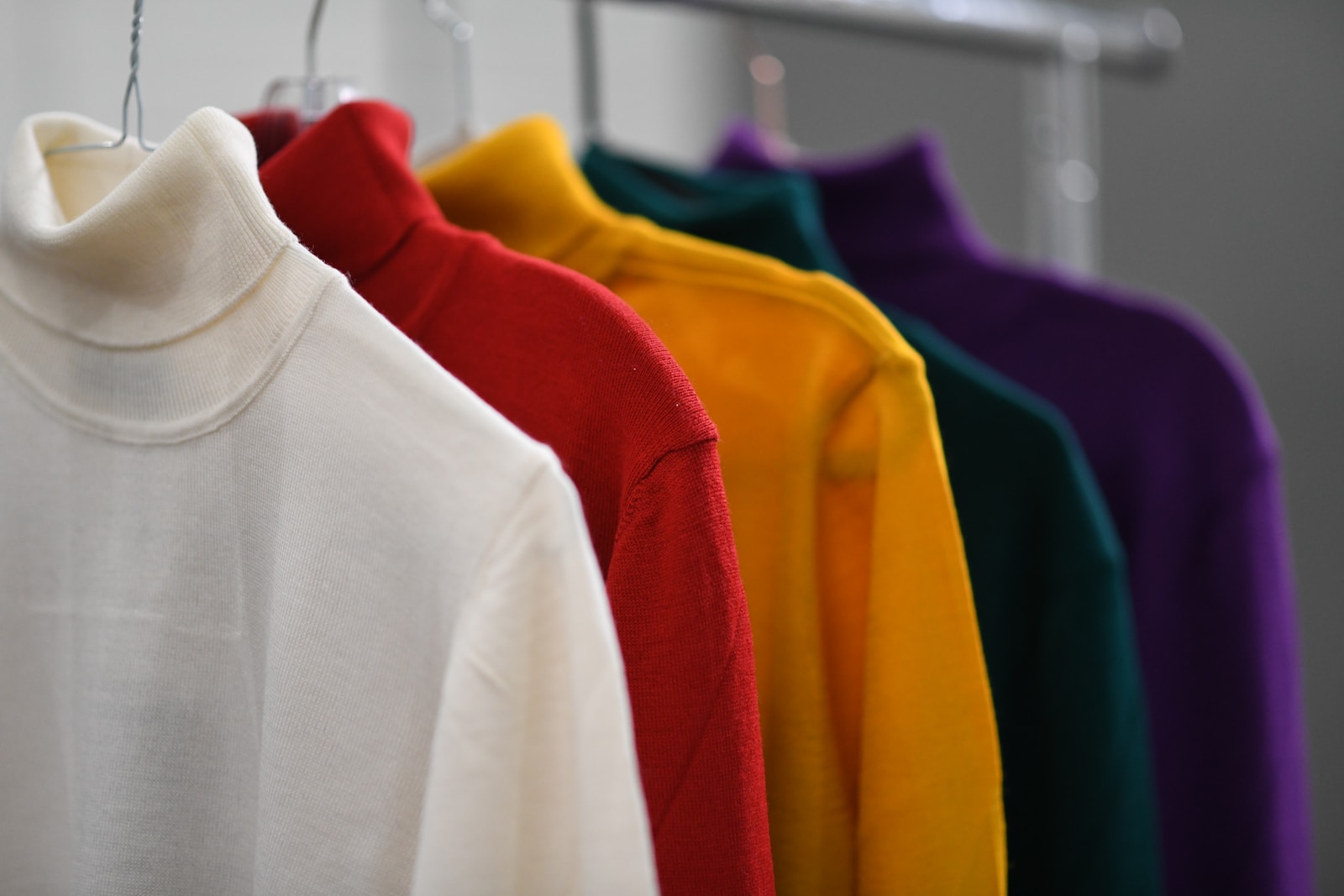Introduction
The Intricate Interplay of Mock Necks and Turtlenecks in Fashion
The world of fashion is a vibrant palette, an expressive canvas where trends blend, diversify and morph through time. Among the myriad styles that exist within this dynamic realm, two timeless pieces continue to hold sway – the mock neck and turtleneck.
Defining, yet subtly different from each other, these styles have a unique versatility that makes them perennial favorites across seasons and occasions. While they are often used interchangeably due to their visual similarities, mock necks and turtlenecks carry subtle nuances in design and function that set them apart.
Both styles have ascended from their simplistic origins to become key elements in the high-octane world of contemporary fashion. Let us dive into these fascinating style staples to explore their individual identities as well as discern what separates one from the other.
Brief Overview of Mock Necks and Turtlenecks
Decoding the Terminology: Mock Neck vs Turtle Neck
A mock neck is characterized by its moderate height which barely grazes the base of your neck. The defining aspect is that it stands up around your neck without folding over like its counterpart – the turtleneck.
The turtleneck on the other hand is a higher rising neckline typically extending past your chin towards your jawline. A distinguishing feature is its fold-over fabric creating a double layer effect which can be adjusted based on personal preference for tightness or looseness around the throat.
Importance and relevance in fashion industry
The Silent Workhorse: How Mock Necks & Turtlenecks Shape Style
In an age where fashion statements are fluidly evolving, both mock necks and turtlenecks continue to remain impressively relevant in high-fashion circles thanks to their innate simplicity paired with sophistication. Both designs effortlessly bridge gaps between casual wearability and professional formality making them valuable additions to any wardrobe repertoire.
They offer a modest yet stylish solution for transitional weather while also serving as layering essentials during colder months. In essence, these timeless garments command attention not just as seasonal staples but also as year-round elements integral to crafting aesthetically pleasing ensembles that resonate with contemporary tastes while retaining classic charm.
The Tale of Two Necks: A Historical Journey
The Genesis of the Mock Neck
The origin of the mock neck, a sartorial innovation in its own right, stands shrouded in history’s cloudy veil. Although pinpointing an exact date for its inception remains an elusive task, it is widely acknowledged that this distinctive style emerged during the late 19th and early 20th centuries. Initially conceived as a practical garment for fishermen and naval personnel, the mock neck provided essential warmth without compromising mobility.
Fast forward to the 1960s, and we find the humble mock neck transformed into a powerful fashion statement. With style icons like Audrey Hepburn endorsing it with elan in ‘Funny Face,’ this previously utilitarian garment became synonymous with chic elegance and sophistication.
A Twist in Time: The Evolution of Mock Neck
The evolution of the mock neck is a testament to fashion’s adaptability and resilience. It has seamlessly traversed various eras, each time adopting contemporary elements to stay relevant.
In the flamboyant 70s disco era, it morphed into tighter fitting versions accentuating body contours. The 90s saw its reincarnation in softer fabrics paired with minimalist aesthetics underlining grunge culture’s influence.
In our present day, the mock neck continues to be a versatile staple adeptly straddling casual and formal boundaries. Whether incorporated into sleek office attires or paired with jeans for laid-back outings, it proves its enduring appeal.
Unravelling Turtleneck’s Rich Tapestry
The turtleneck holds an even richer historical significance than its cousin – harking back as far as medieval times when knights wore them beneath their armour for protection against chafing metal suits! But it was during the Victorian age that turtlenecks truly found their footing – lauded for covering women’s décolletage modestly while adding elegance to their attire. But historical records show that it wasn’t until late 19th century when workers adopted them as protective wear against harsh weather conditions marking their transition from haute couture to utilitarian clothing.
The Turtleneck’s Metamorphosis: An Enduring Icon
Like many garments over time, turtlenecks underwent transformation reflecting changing societal norms and trends. From modest beginnings in Victorian wardrobes turned workers’ wear came a major turning point in mid-20th-century when they became symbols of intellectualism adopted by artists and philosophers alike — think Pablo Picasso or Steve Jobs’ iconic black turtleneck! Fashion designers further revolutionized this classic piece by introducing myriad variations – from oversized slouchy styles suitable for winter chill to light cotton versions perfect for transitional weather – cementing its status as both functional wardrobe staple & timeless fashion icon.
Understanding Mock Necks
The Quintessence of a Mock Neck
A mock neck, often considered as the turtleneck’s casual cousin, is characterized by a shorter, nearly collar-length neckline that stands up around the neck. Unlike its relative, it does not fold over and creates an illusion of elongation without swallowing the neck completely.
The simplicity of its design makes it an ideal versatile piece in every wardrobe. The distinguishing attributes of a mock neck lie in its length and fit details.
Less constricting than a traditional turtleneck, it usually extends only an inch or two above the collarbone. The fit tends to be more relaxed and easy-going.
Characteristics & Versatility of Mock Necks
Common materials used for mock necks range from lightweight cotton blends for warmer climates or seasons to heavier knits like wool for chilled settings. This versatility in fabric options allows for year-round wearability. Mock necks have found prominence on both catwalks and sidewalks owing to their minimalist aesthetic appeal.
They serve as the perfect canvas for statement jewelry or can add a sophisticated twist when layered under blazers or jackets. Appropriate occasions vary widely; they are at home everywhere from casual days out to more formal settings.
Understanding Turtlenecks
The Anatomy of a Turtleneck
A turtleneck features a high neckline that covers most of the throat and typically folds over itself forming what looks like a soft ring around your neck. Its origins trace back centuries where it was used primarily as protective garb against harsh weather conditions before finding favor within mainstream fashion.
Its defining characteristics include its length which extends several inches above the base of the neck enveloping much of your throat area providing warmth and coverage like no other neckline can offer. This is partially why it continues to be favored during colder months.
Diversity & Utilization of Turtlenecks
Turtlenecks are often crafted from materials such as wool, cashmere, jersey knit fabric or cotton blends depending upon their intended use whether layering during cold seasons or standalone pieces in milder climate. Turtlenecks have enjoyed extensive fashion moments – from being associated with beatnik culture to gracing haute couture runways worldwide. They can be effortlessly dressed up with tailored trousers for office wear or pared down with jeans giving them enduring versatility right through decades.
The Key Differences between Mock Necks & Turtlenecks
An Examination based on Design & Structure
While both styles might appear similar at first glance, careful inspection unveils nuanced differences which primarily stem from their distinct designs and structures. As discussed earlier, while both extend upwards from base line of your neckline – turtlenecks cover more skin providing ample warmth whereas mock-necks are shorter offering style without sacrificing comfort.
A Study based on Comfort & Functionality
In terms of comfort and functionality too – these cousins differ subtly yet significantly; While turtleneck’s extended length lends itself beautifully towards insulation during winters – some might find this amplitude restrictive thereby preferring mock-necks which boast less constriction while still offering proportionate coverage. The realm where these two really differentiate themselves lies in style versatility – While classic turtleneck might seem austere and overly formalistic; the modest heighted mock-neck carries an air about itself that feels less severe rendering it suitable for wide array appearances
Few Lesser Known Facts about Mock Necks & Turleneckers
Mock-necks were initially designed by golfers who wanted protection against chilly mornings but didn’t want extra material swinging around whereas Turlenecker was originally known as “polo-neck” because polo players would wear these as part protective gear during game-play. These seemingly simple sartorial pieces carry rich history along-with understated elegance making them vital addition to any discerning wardrobe
: Whether you choose a robust turleneck promising warmth amidst chilly winter nights or lean towards breezy adaptability offered by humble mock-neck – either choice will ensure you stay fashionable whilst enjoying distinct inherent benefits each brings along. Remember though – Fashion should never dictate one’s personal style; rather let your unique individuality shine through in how you prefer wearing either one!
 Skip to main content
Skip to main content


